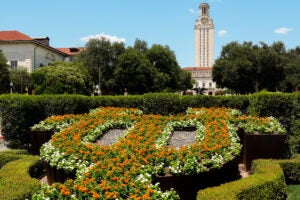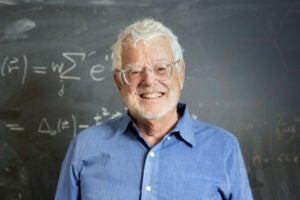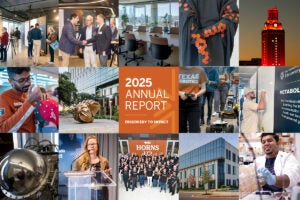The following geophysicists, engineers, and social scientists with expertise in earthquakes, some specifically regarding Japan and the Pacific Rim, are available to talk on today’s earthquake in Japan, the tsunami affecting the Pacific region, impacts of earlier earthquakes and tsunamis on Japan, and safety issues related to construction and nuclear engineering in Japan.
Earthquakes and Seismology
Nathan Bangs, senior research scientist, Institute for Geophysics
512-471-0424
nathan@utig.ig.utexas.edu
Bangs is a specialist in the tectonic processes that cause major earthquakes with particular experience in Japan, working closely with Japanese scientists studying the Nankai Trough, a major earthquake-producing zone in Southern Japan. He specializes in seismic imaging of subduction zones (such as the one that triggered the latest quake) and fault structure to make pictures of the faults involved in major earthquakes.
Cliff Frohlich, associate director, Institute for Geophysics
512-471-0460
cliff@ig.utexas.edu
Frohlich is a general expert on deep earthquakes and seismology. As associate director of the Institute for Geophysics he has worked with teams of geophysicists studying earthquake regions in Japan and tsunamis in the Pacific.
Sean Gulick, research scientist, Institute for Geophysics
512-471-0483
sean@ig.utexas.edu
Gulick is a specialist in the tectonic processes that cause major earthquakes with particular experience in Japan, working closely with Japanese scientists studying the Nankai Trough, a major earthquake-producing zone in Southern Japan. Gulick has been involved in five oceanographic cruises near Japan, using submersibles, ocean drilling and seismic instruments to image the subsurface.
Tsunamis
Matt Hornbach, research associate, Institute for Geophysics
512-471-0462
matth@utig.ig.utexas.edu
Hornbach uses seismic techniques to image, model and ultimately link shallow geological structure with stress and fluid flow below the seafloor. This research is directly applicable to the generation and propagation of tsunamis.
Nuclear Expertise
Erich Schneider, assistant professor, Mechanical Engineering
Cockrell School of Engineering
512-232-5412
eschneider@mail.utexas.edu
Schneider offers expertise on the safety and integrity of nuclear facilities following a catastrophic natural occurrence. His expertise includes nuclear systems engineering, nuclear fuel and reactor technologies, and sustainability of nuclear power.
Oguzhan Bayrak, associate professor, Civil, Architectural and Environmental Engineering
Cockrell School of Engineering
512-232-7826
bayrak@mail.utexas.edu
Bayrak’s research interests include behavior, analysis and design of reinforced and prestressed concrete structures; bridge engineering; evaluation of structures in distress; structural repair; fiber reinforced polymers and earthquake engineering. He can also speak to the safety and integrity of nuclear power plants.
Power and Telecommunications Infrastructure
Alexis Kwasinski, assistant professor, Electrical and Computer Engineering
Cockrell School of Engineering
512-232-3442
akwasins@mail.utexas.edu
Kwasinski made two trips to Chile following the February 2010 earthquake to take inventory of the damage on power and telecommunications infrastructure, as well as other factors that are essential to everyday normal operations. He also shared ideas on how to better prevent future power failures following earthquakes. His research interests include analyzing the effects of natural disasters on critical power infrastructure, such as communication networks power supply, and studying ways of reducing the vulnerability of these critical power infrastructures to such severe events.
Assessing and Predicting Soil Earthquake Hazards
Ellen Rathje, professor, Civil, Architectural and Environmental Engineering
Cockrell School of Engineering
512-293-4565
e.rathje@mail.utexas.edu
Rathje’s expertise and research focus on understanding and predicting geotechnical earthquake hazards, with particular emphasis on the evaluation of earthquake-induced landslides (slope instability, soil liquefaction), the effect of soil conditions on earthquake ground motions and the use of remote sensing to document earthquake hazards. Last year, she led a team of engineers and scientists to examine damaged areas wrought by the earthquake in Haiti.
Impacts of Earlier Earthquakes and Tsunamis on Japan
Nancy Stalker, associate professor, Asian Studies and History
512-475-6044
nancy.stalker@mail.utexas.edu
Stalker focuses her research on the relationship between cultural and religious practice and national identity in modern Japan. She is available to discuss historically significant earthquakes and tsunamis in Japan, and the impact of natural disasters on Japan society.
John W. Traphagan, associate professor, Religious Studies
512-232-0874
jtrap@uts.cc.utexas.edu
Traphagan is an anthropologist who conducts research on culture and society in Japan, with an emphasis on religion, family, aging, death and dying and health. He has spent a total of four years in Iwate Prefecture conducting ethnographic research on the culture and life of that region, which was hit by the earthquake and earthquake-triggered tsunami. Traphagan is widely known for his research on aging in Japan and has particularly strong expertise in the area of eldercare and rituals related to caring for the dead. He is available to discuss how the earthquake has impacted the people of Japan, and how they will cope with the aftermath, and particularly issues related to family and the elderly.
Foreign Relief Assistance
Patricia Maclachlan, associate professor, Government
512-232-1724
pmaclachlan@mail.utexas.edu
Maclachlan specializes in Japanese foreign policy, international relations of East-Southeast Asia, politics in Japan and Japanese culture. She is available to discuss topics relating to foreign relief assistance to Japan.
Structural Safety
Wassim Ghannoum, assistant professor, Civil, Architectural and Environmental Engineering
Cockrell School of Engineering
512-232-0897
ghannoum@mail.utexas.edu
Ghannoum traveled to Haiti with a team of architects and engineers following the magnitude 7 earthquake that shuddered the country Jan. 12, 2010. Ghannoum and the team assessed the safety of structures, mainly hospitals and ports, and provided recommendations for tagging buildings as either safe or unsafe. His expertise include design and behavior of reinforced concrete (RC) structures; large-deformation behavior of RC structures; earthquake engineering; structural dynamics; advanced analytical modeling of RC structures.
Jim Jirsa, professor, Civil, Architectural and Environmental Engineering
Cockrell School of Engineering
512-232-1706
jirsa@uts.cc.utexas.edu
Jirsa’s expertise centers around design and behavior of reinforced concrete structures, earthquake engineering and repair and rehabilitation of structures. Jirsa has authored several books on earthquake engineering, including one that analyzes structure damage in the 1994 Northridge Earthquake.
Richard E. Klingner, professor, Civil, Architectural and Environmental Engineering
Cockrell School of Engineering
512-232-3597
klingner@mail.utexas.edu
Klingner’s expertise is in experimental and analytical investigation of the response of masonry and reinforced concrete masonry structures, earthquake engineering and anchorage to concrete.
Sharon Wood, professor, Civil, Architectural and Environmental Engineering
Cockrell School of Engineering
512-471-4558
swood@mail.utexas.edu
Wood has been nationally recognized for her research and expertise on earthquake engineering, reinforced concrete structures and the evaluation of existing structures. She studied buildings in the 1985 earthquake in Vina del Mar, Chile, and the 1994 Northridge earthquake in California. During that time, she made recommendations to prevent structure failure in the future.



